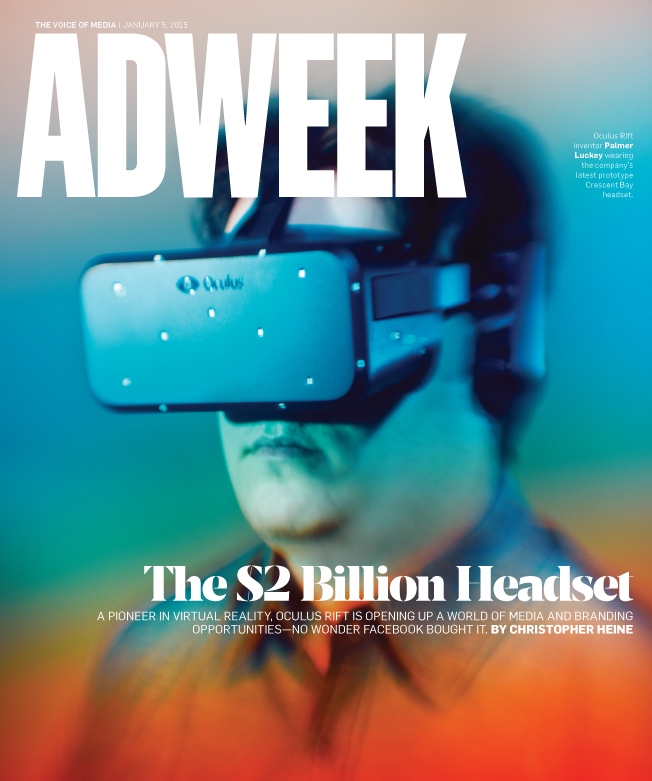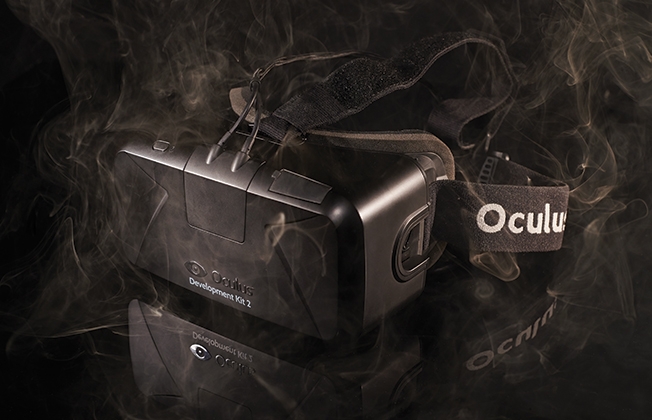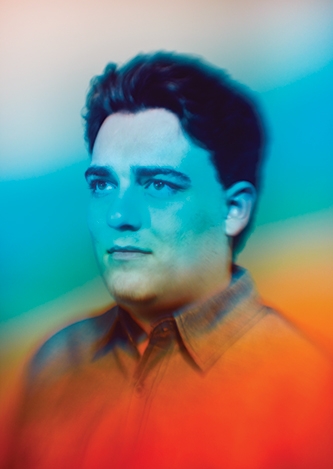By Christopher Heine for AdWeek.

Photo: Maciek Jasik
Nancy Bennett is a virtual-reality marketing veteran. (Yes, such people actually exist and are about to become hot commodities among talent recruiters.) In the mid-2000s, Bennett had her avatar boots on the Internet-code-built ground ofSecond Life, constructing cyber experiences for her employer at the time, MTV Networks.
Of course, Second Life never really took off. So with her been there, done that perspective several years later as chief content officer at Two Bit Circus, she does not deal in hyperbole when it comes to the impact the much-hyped virtual reality headset Oculus Rift will have on marketing. Rather, Bennett leans on data. One-third of her agency’s new business in 2014 was powered by the Oculus Rift developer’s kit, helping grow her 2-year-old Los Angeles digital shop from 15 to 35 employees.
 Oculus Rift’s developer kit provides a glimpse into the future. Photo: Maciek Jasik
Oculus Rift’s developer kit provides a glimpse into the future. Photo: Maciek Jasik Oculus, you see, isn’t just an oxygen mask for fantasies—it has the potential to do nothing short of inventing a whole new universe of marketing.
“We didn’t really have any virtual-reality work this time last year,” says Bennett. “Now we’ve built our own camera rigs, we’ve built our own livestream viewing capability, so directors can actually see the [360-degree] spherical projection while they are on set. It’s a lot of technical geekery going on, but this enthusiasm is not just because the space seems to be blossoming. There’s a lot of forces at work—look at what Facebook has invested in VR.”
Indeed, Oculus Rift—Facebook’s $2 billion baby—this year could be shot out of a cannon (think of that view from the headset, literally speaking). The device is quickly losing its obscure-curiosity status after a couple of years of generating media coverage and lots of buzz at the Consumer Electronics Show and South by Southwest. And as that excitement spills over into the mainstream, Oculus may well become for virtual reality what the camera obscura was for photography two centuries ago.
“I knew that virtual reality would become important to the public at some point, but I thought it would take a much longer time,” Oculus Rift founder Palmer Luckey confesses to Adweek. “I did not take into account the fact that unlike some new technologies, VR has already established mindshare as a concept.

Oculus Rift founder Palmer Luckey. Photo: Maciek Jasik
Time travel, flying cars, artificial intelligence and VR are all sci-fi staples—and we are in the lucky position of bringing one of those things to life.”
That said, the virtual-reality market is anything but a one-horse race. Google is gearing up to ship 500,000 units of its $45-or-less Cardboard VR headset, while the forthcoming $200 Samsung Gear VR, powered by Oculus software, has been met with great expectations. Meantime, Oculus Rift and Facebook are being extremely tight-lipped about details around their own consumer headset, though it’s been reported it will hit the market sometime this year and will be priced anywhere from $200 to $400.
Whether consumers will be willing to pay such a rich sum for the device could bar it from achieving scale in the near future. And scale, of course, is what most advertisers need to take it seriously.
That may not be an issue for long: MarketsandMarkets projects that VR hardware will generate $66 million in revenue in 2015—a small total to be sure, but still a 164 percent increase from 2013. Naturally, gadget-native millennials will drive much of the market. According to a Deep Focus survey of 1,203 young adults, 51 percent had heard about Oculus and similar devices, with 41 percent signaling they were interested in trying one out.
“Millennials will definitely want to get their heads in the game,” says Chelsea Krost, a Gen Y-focused analyst and TV host.
On the topic of games, they, too, are a key driver of this market, with popular titles like Call of Duty and Halo crucial to Oculus’ prospects. In fact, talk to anyone in the tech space and they’ll tell you gaming is the gateway to wide adoption of VR devices.
“It is going to be what gets the headset onto more faces, and that will lead to other types of content,” predicts Jim Hord, executive creative director at Havas Worldwide. “Xbox, for instance, is a gaming console, but also your conduit to the Web and you can stream movies. It’s a media platform.” Hord foresees Oculus as evolving as a consumer product in much the same fashion.
The potential for Facebook CEO Mark Zuckerberg and company in terms of melding VR and social into a new type of mobile platform certainly stirs the imagination. There have been rumors about Facebook getting deeper into video with original content that seems to dovetail with where marketers see this relationship going.
“The future of Oculus Rift is most likely in gaming and entertainment, areas that Facebook will need to be in if it expects to follow the data that consumers create,” says Ian Schafer, CEO and founder of Deep Focus. (Facebook declined to comment for this story.)
Rebecca Lieb, a Facebook analyst at Altimeter Group, adds, “This is likely a much longer-term strategy as the adoption curve is so high. But Oculus can serve as a test bed for new forms of marketing.”

Luckey experiments in his lab. Photo: Maciek Jasik
The Marketing Angle
Major brands have big plans for the year ahead, as many have already trialed one of the 100,000 developer kits Oculus distributed to media players, agencies, brands and vendors in 2014. For example, Hearst’s Elle magazine plans to livestream a fashion show in the coming months through Oculus Rift, Samsung Gear VR or Google Cardboard. Elle has already dipped a toe in the space, featuring a VR-friendly photo spread of 17-year-old pop sensation Jacquie Lee in the iPad edition of its December issue.
“It’s going into environments that the consumer heretofore never had access,” says Kevin O’Malley, svp and publisher of Elle. “That could be a tiki hut jutting over gentle waters in Polynesia, or it could be front row at a fashion show that they normally only see on TV, where they can see the celebrities who are there. It’s quite another thing to be front row, and when you turn to your left you are sitting next to celebrity X, Y or Z.”
Elle, which works with VR specialty shop Jaunt for such productions, is lining up sponsors, but O’Malley declined to name any. “We are moving quickly on this,” the publisher says. “Why is that? What do advertisers want most? Engagement with a captive audience. I would say that is a core competency for virtual-reality content.”
Marriott, also buoyed by its own early VR adventures, is considering making the Oculus Rift a permanent fixture inside its hotels this year. The chain took the headset on an eight-city tour last fall, offering guests one-minute, fantastical glimpses of Maui’s Waianapanapa Black Sand Beach and central London from the dizzying heights of gigantic skyscraper Tower 42. The initiative, dubbed #GetTeleported, let consumers share split-screen videos of themselves via Facebook and Twitter, distributing the VR experience through all their social connections.
Meanwhile, Marriott also partnered with Reddit for a contest that challenged the site’s visitors to share why the Oculus Rift should come to their city. (Cincinnatians prevailed.) All told, that campaign generated 230 million social media impressions, explains Michael Dail, vp of global brand marketing at Marriott.
“People said it inspired them to take their own trip,” reports Dail. “And the shareable social moment helped them talk about it with their friends.” From here on, the hotelier is weighing other services that employ VR, including in-room entertainment and conference spaces.

Luckey demonstrated Oculus Rift’s potential to CES attendees in a
suite at the Venetian in 2012 before Facebook acquired it.
Photo: Alfred Maskeroni
Destination B.C., British Columbia’s tourism bureau, had wrestled with how to attract travelers from elsewhere in North America and Europe before opting to invest $550,000 in an Oculus-powered production featuring helicopters and GoPro cameras. Capturing the province’s awesome mountain ranges and the peninsula around Port McNeill on Vancouver Island with three-minute films, users find themselves soaring above groves of ancient trees and virtually hanging out with other travelers on a boat while spotting sea lions.
The 360-degree videos will live on an Oculus content platform that’s set to go live early this year. Destination B.C. also plans to distribute the clips via a partnership with Thomas Cook, a U.K.-based travel agency that will outfit its U.K., German and Belgian locations with the Oculus Rift.
“You don’t have to simply lean on telling consumers things like, ‘The trees are this big.’ That sense of being there is such a powerful tool,” notes Janice Greenwood-Fraser, a representative for the tourism authority. “It brings it to life in a way that no photo or regular video can.”
It Ain’t Cheap Today
Cost remains a barrier to VR’s adoption among advertisers. A straw poll of marketers who are experimenting with the technology reveals that a three-minute VR video can cost more than $1 million to produce. Yet as hardware and software products iterate, creative will become less pricey, ostensibly enticing more brands.
Felix & Paul Studios, which works exclusively in the virtual-reality space, is counting on it. The Montreal-based startup, which counts Dos Equis among its clients, has even created a video dubbed “Introduction to Virtual Reality” for both the Oculus and Samsung headsets. “It’s not a space that has clearly taken shape” yet, says Felix Lajeunesse, the shop’s co-founder. “So it’s an interesting time for exploration.”
In yet another example of VR adoption, the Canadian sporting goods chain SportChek last year launched an 80,000-square-foot flagship store in Edmonton, Alberta, designed completely with the Oculus and featuring some 450 digital displays, some of which are intuitive. For example, a screen in the golf department will tell a customer what type of putter he or she is trying out.
Brooklyn, N.Y.-based digital agency Huge designed the store, and is using the same approach for client Sonic Automotive for its new flagship location in the Denver area.
“We want to understand the foot-traffic flow and the lines of sight in the store,” explains Derek Fridman, group creative director at Huge. “Oculus allows us to weave digital into the physical cohesively, rather than being kind of shoe-horned—or slapping a television screen on a wall. And while we could show PowerPoint presentations and pitch videos all day long, if we can put an Oculus on a client’s head and let them stand in the space and see how the digital works, it’s a completely different way of presenting your work.”
With that in mind, expect to witness numerous Oculus-driven stunts in the year ahead. Digital shop Magnetic is retooling an Oculus Rift device so that visitors to this year’s SXSW in Austin can fly drones in the Texas sky.
“Imagine seeing a drone 700 feet over your head, and you control where it goes,” describes Brian Schultz, partner at New York-based Magnetic. “Instead of creating a fictional reality, we are creating a real reality.”

